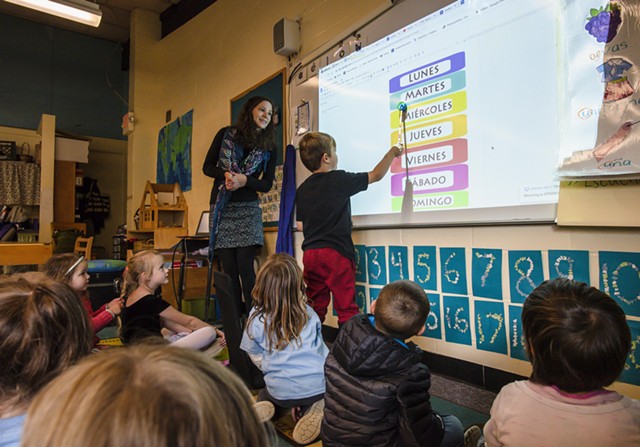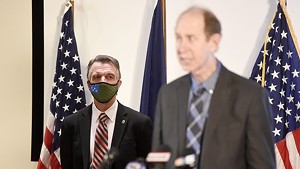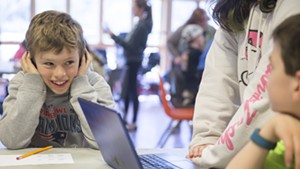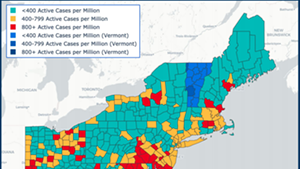
- File: Glenn Russell for Kids VT
- A Spanish lesson at Jericho Elementary School
Vermont's schoolchildren will return this fall to vastly different school systems that feature temperature checks to board school buses, mandatory face coverings, closed cafeterias and hand-sanitizer stations at school entrances.
Those measures are included in 23 pages of guidance for K-12 public and private schools that Vermont's Agency of Education and Department of Health released on Wednesday.
Drafted with input from infectious disease experts, pediatricians, and public health and education professionals, the document — “A Strong and Healthy Start: Safety and Health Guidance for Reopening Schools, Fall 2020” — aims to decrease the risk of transmission of COVID-19 among staff and students.
The document states that the guidance may evolve and will be updated as new information becomes available. What is certain, though, is that schools will look and feel markedly different than they did when students were dismissed in mid-March, with enhanced physical distancing measures in place.
Guidelines include daily health screening for students and staff — involving both verbal questions and a temperature check — at the first point of contact. That means students dropped off at school will be checked before they enter the building. Those who take a bus must be screened before they even board. If a student has a temperature of 100.4 degrees or higher, they will be sent home.
If COVID-19 is confirmed in a student or staff member, the school areas they had used will be closed off, cleaned and disinfected.
Additional measures include hand-sanitizing stations and the disinfecting of common spaces and frequently touched surfaces at the beginning, middle and end of each day.
Both students and staff must wear facial coverings — cloth masks or clear facial shields — while inside the school building. If they can't maintain six feet of social distancing when outside, their faces must be covered. That can be waived for students with medical or behavioral conditions that prevent them from wearing a mask.
Visitation to schools will be curtailed extensively, and parents will not be able to enter when they drop their kids off.
The document outlines physical-distancing measures that should be implemented to reduce contact between students. When feasible, the same group of students should stay in their designated classroom, and the same teachers and staff should remain with those students all day. The guidance notes that this “will need to be addressed differently to meet the needs of high school (and maybe middle school) students,” but it does not specify what this might look like.
Within classrooms, desks should be spaced six feet apart and facing in one direction. The sharing of art supplies and computer and lab equipment should be limited. Communal spaces including the cafeteria and gymnasium should be closed unless they are needed for additional classroom space. Students will eat lunch in their classrooms.
Outdoor recess space can be used as long as physical distancing is possible, and playground equipment should be cleaned frequently throughout the day. The teacher’s lounge should be closed, and physical barriers should be installed in reception areas and employee work spaces where distancing isn’t possible.
Group activities with the potential to generate increased respiratory droplets and aerosols, such as singing and music involving brass and woodwind instruments, are to be avoided.
To aid in contact tracing, students should have assigned seats. Staff members should keep track of all those who enter their classrooms and are encouraged to keep a daily list of those they come into close contact with.
Libby Bonesteel, superintendent of Montpelier-Roxbury Public Schools, shared her initial thoughts about the document via email. She said she was anticipating much of the guidance related to masks, physical distancing and health checks. Her district is already developing plans for those protocols.
Bonesteel said there were several parts of the guidance she found contradictory. The document states that if children are too young to answer the verbal health screening questions accurately before they enter school, a parent should remain with them. But because parents are not allowed in the building, that means that, in her district, there will be upwards of 250 children and their parents who will have to wait outside each day for screening.
The transportation requirements will be an issue, particularly for rural towns and schools, said Bonesteel. “It is not a bus driver’s job, nor should it be, to do health screenings on children," she wrote. "Hiring bus monitors will be extremely hard for school districts.”
Vicki Graf, principal of Jericho Elementary School, also had concerns about the expense of daily health screenings and additional supplies. Said Graf: “I think our school districts are going to need support from the state to cover these costs.”
The guidelines are here:
















Comments
Comments are closed.
From 2014-2020, Seven Days allowed readers to comment on all stories posted on our website. While we've appreciated the suggestions and insights, right now Seven Days is prioritizing our core mission — producing high-quality, responsible local journalism — over moderating online debates between readers.
To criticize, correct or praise our reporting, please send us a letter to the editor or send us a tip. We’ll check it out and report the results.
Online comments may return when we have better tech tools for managing them. Thanks for reading.